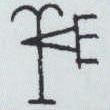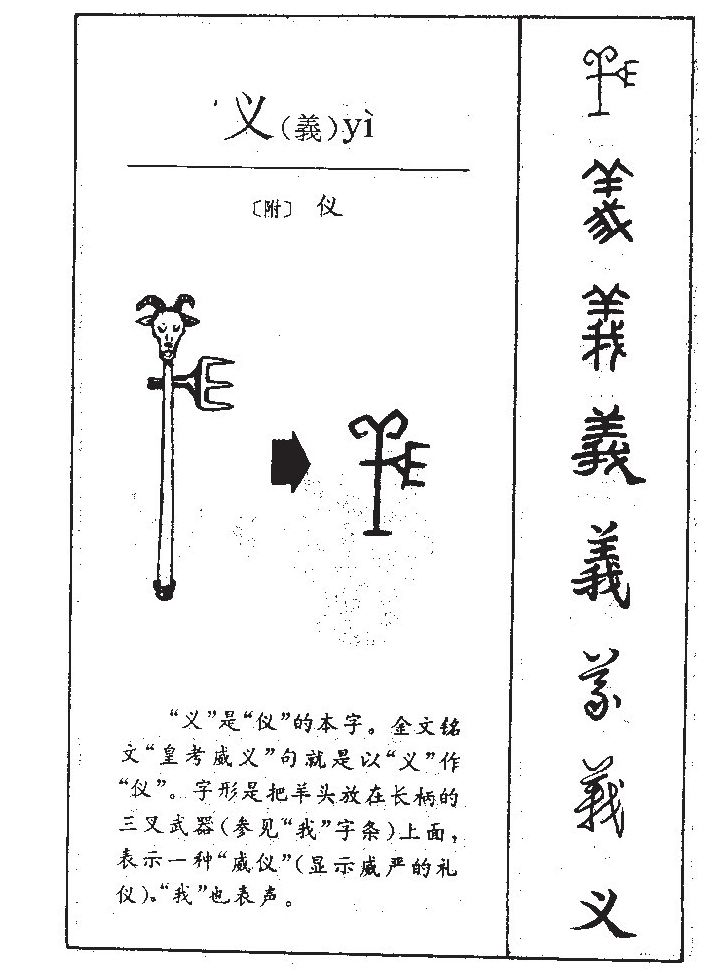“A Lamb over Me”?
Asher Chee |In this series of articles ([1], [2]), we have been evaluating the Chinese Character Truths theory, that Bible truths were encoded into certain Chinese characters by the ancient Chinese people. In this article, we will examine a popular Christian claim regarding the Chinese character 義 yì:
This Chinese character for righteousness (義) is made up of two parts: lamb (羊) at the top, and me (我) at the bottom. To be made righteous, we must be covered by the Lamb of God, Jesus Christ! Could it be that the ancient Chinese were aware of this concept? Were they aware that they need the Lamb over them to be made right with God?
Remember that the 義 yì character that we use today was completely unknown to the earliest writers and readers of Chinese characters, since they used Oracle Bone Script (甲骨文).
Here is how the original 義 yì character was written:

An explanation for the 義 yì character is found in the following entry in the reference book on the history of Chinese characters:

“义”是“仪”的本字。金文铭文“皇考威义”句就是以“义”作“仪”。字形是把羊头放在长柄的三叉武器(参见“我”字条)上面,表示一种“威仪”(显示威严的礼仪)。“我”也表声。 — 《汉字字源》
The character 义 [the simplified form of the 義 yì character] is the origin of the character 仪. In the Bronze Script inscriptional phrase “皇考威义”, the character 义 stands for the character 仪. The form of the [Oracle Bone Script] character depicts placing a goat’s head on the top of a long-handled three-pronged weapon (c.f. the 我 element), representing a kind of “reverential etiquette” (expressing the decorum of majesty). The 我 element also represents pronunciation. (The Origins of Chinese Characters)
The top part of the 義 yì character is the 羊 yáng element, which theorists identify as signifying a lamb. However, in its original Oracle Bone Script form, the 羊 yáng element actually signified a goat, and not a lamb. The bottom part of the 義 yì character is the 我 wǒ element, which originally signified a long-handled three-pronged weapon. Thus, in its original Oracle Bone Script form, the 義 yì character depicted “a goat’s head on the top of a long-handled three-pronged weapon”, and not anything close to “a lamb over me”.
On its own, the 我 wǒ character could be used as a first person pronoun, meaning “I” or “me”. However, when the 我 wǒ character is used as an element in the 義 yì character, it functions as a phonetic component, indicating how the character was pronounced historically. Indeed, the 我 wǒ element is found in other characters which were historically pronounced similarly:
| Character | Old Chinese Pronunciation |
|---|---|
| 莪 | ŋaːl |
| 哦 | ŋaːl |
| 娥 | ŋaːl |
| 峨 | ŋaːl |
| 峩 | ŋaːl |
| 鵝 | ŋaːl |
| 俄 | ŋaːl |
| 蛾 | ŋaːl / ŋralʔ |
| 睋 | ŋaːl |
| 涐 | ŋaːl |
| 誐 | ŋaːl |
| 硪 | ŋaːl / ŋaːlʔ |
| 我 | ŋaːlʔ |
| 騀 | ŋaːlʔ |
| 餓 | ŋaːls |
| 義 | ŋrals |
| 儀 | ŋral |
| 轙 | ŋral / ŋralʔ |
| 檥 | ŋral / ŋralʔ |
| 蟻 | ŋralʔ |
| 艤 | ŋralʔ |
| 礒 | ŋralʔ |
| 議 | ŋrals |
Conclusion
Jesus Christ is the lamb of God who takes away the sin of the world (John 1:29), and everyone who believes in him is made righteous before God (Romans 3:24–25). However, it would not be honest to claim that the 義 yì character was created to encode this truth.

